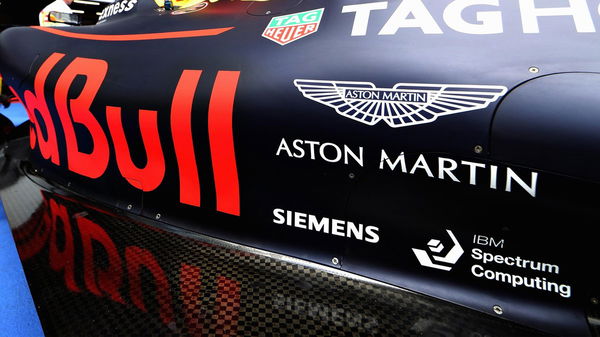

The news is out. Aston Martin is going to be Red Bull’s title sponsor starting next year.
And this a logical step considering the close nexus between the two teams. But the question of the British Sports car manufacturer becoming an engine supplier for the Milton Keynes based team remains.
This much is guaranteed that any foray into an engine supplier role in F1 is a post-2020 option. Aston Martin’s attendance in FIA’s engine regulation summit attests to this probability.
ADVERTISEMENT
Article continues below this ad

via Imago
Red Bull
FIA’s engine regulation summit is tasked with deciding the next-gen engine formula. The first meeting took place at the end of March. The agenda was to call for prospective suppliers to submit proposals by May 31. The Summit is now officially being called the Power Unit Working Group. The group is said to be meeting regularly the ‘when’ of it not being known to us.
The object of these discussions is to specify the next-gen F1 engines: fast, powerful, loud, hybrid, economical and ‘green’. Yet, they should be sufficiently high-tech to appeal to motor manufacturers without being complicated. They should also be cheap enough to lure independents to produce power units capable of winning for sale to private teams.

In the meetings held so far, current suppliers Ferrari, Mercedes-Benz, Renault, and Honda were all present, with Aston Martin also accepting the invitation extended by the governing body to members of its Manufacturers’ Commission, a panel for carmakers that includes Porsche, Alfa Romeo and Audi et al.
Also pitched in were independent race engine supplier Ilmor, headed by Mario Ilien, and Cosworth.
Of course, accepting invitations to exploratory meetings and building F1 race engines are activities about as far apart as the two ends of the English Channel.
Attending FIA meetings is all to intents and purposes free, with the benefits of networking alone surely offsetting the time and costs, yet lingering questions remain. What would a specialist carmaker, one without support from major brands (as enjoyed by Ferrari and Lamborghini from Fiat/Alfa Romeo and VW Group respectively), hope to gain by sitting at F1’s main technical table?
True, Mercedes holds a 5% stake in Aston Martin, but the share was granted in exchange for collaboration on technologies such as infotainment, safety devices and supplies of Mercedes AMG engines for future models rather than through direct investment. Aston Martin is controlled by a consortium comprising Kuwait’s Investment Dar and Italy’s Investindustrial private equity fund, among others.
When questioned about it, Aston Martin officially stated that they accepted the invitation as one does not turn down an FIA invitation, which makes perfect sense, on the surface at least. Dig deeper, though, and that raises a second question. Why despatch CEO Andy Palmer to Paris, not chief technical officer Maximilian Szwaj, who was recruited from Ferrari in 2016, and whose CV lists spells at such as Maserati, BMW and Porsche?
No disrespect to Palmer, of course, but surely the CEO of a rapidly expanding supercar company has better things to do with his time than munch through speculative chatter about nuts and bolts of engines for a category the brand is only peripherally involved in as Red Bull Racing’s ‘innovation partner’?

True, Palmer, a chartered engineer, previously held numerous technical postings within the UK and Japanese motor industries, and held ultimate responsibility for Nissan’s global motorsport programme – which culminated in Infiniti badging on Red Bull racers – and was responsible for Nissan’s Leaf electric car project. In addition, Palmer holds a doctorate in engineering management and acts as a guest professor to a Tokyo university.
But his CEO role suggests strategic interest in F1 engines rather than a need for technical insight, further compounding the questions above. What is Aston Martin’s interest in F1? Why despatch Palmer at all – particularly when Aston Martin’s reported 2016 earnings before interest and taxes were just £16million on revenues of £593m? Some F1 operations have higher turnovers.
Further augmenting the general doubt on Aston Martin’s ability to become even an engine supplier by themselves was Andy’s blunt confession that the Supercar marquee does not have enough resources to build engines on its own.
So how a company with earnings less than an F1 team can become an engine supplier?

Both vehicles are due for launch in 2019, and the concept and design of the Valkyrie took shape with considerable input from Red Bull’s legendary chief technical officer, Adrian Newey. Its hardware package consists of a Cosworth-designed V12 power unit supplemented by a F1-inspired ERS device, driving through a Ricardo-designed seven-speed transmission.
By contrast, RapidE, a clever play on the name of Aston Martin’s previous Rapide luxury sedan, is a full electric vehicle. Aston has also revealed that it is ‘hybridising’ a development version of its DB9 V12 sports coupe via a Bosch electric motor fitted to each front wheel, boosting total output from a standard 510bhp by almost 50% to 740, while endowing the car with 16 miles of electric-only range.
That’s quite a roll call of partners: Red Bull Racing/Technology; Williams Advanced Engineering (arguably the best battery development company in the business); Ricardo (architect of the FIA’s Universal Motorsport Engine concept); Cosworth, and Bosch.
All this shows some serious intent by Aston Martin to embrace new technologies, most of which are finding their ways into motorsport’s premier categories, including F1. As an aside, one could start a full-on technical war with those companies as partners.
When CEO Palmer was pressed about the possibility of Aston entering F1 in any shape or form, “Unlike Infiniti, Aston Martin as a company doesn’t have the kind of money to go into Formula 1 and make a decent job of it,” was the measured response. “Unless I thought we could be challenging Ferrari in some way, shape or form, I just wouldn’t contemplate doing it. The best I can tell you is that it’s improbable.”
But then Palmer threw a rider: “I never say never. I have a job to do in terms of getting us back into the conversation amongst people that cross-shop sportscars, be it McLaren, be it Ferrari or Porsche. We need to be in that conversation.”
The Competition

The latest sales statistics show an increase in European sales for Aston Martin of 65% for January-April 2017 over the equivalent 2016 period, well ahead of the direct opposition. Saliently, Europe represents the world’s largest ‘exotic car’ market, with Audi’s R8 range losing 8.2% during that period. Ferrari? Up just 8%, while McLaren was up a whopping 148%, albeit off a small base.
Factor in the tranche of new Aston Martin models to hit the market shortly ahead of the 2020 engine formula change, and Palmer may well need to be in the “conversation” as it pertains to F1 pedigrees. How, though, to achieve that affordably and cost-effectively?
Forget not that Palmer is a past master at cost-effective F1 involvement: The Red Bull/Infiniti deal, masterminded by now-Aston Martin chief marketing officer Simon Sproule in his previous Nissan life, is considered a masterstroke of marketing/badge engineering that ruffled Renault feathers; then the duo managed to place Aston wings on winning Red Bulls and supply road cars to its drivers.
Given that one of the objectives of the new engine formula is to encourage independent suppliers, consider the following scenario for Aston Martin to be in “the conversation” Palmer regularly alludes to: Aston Martin forms a consortium, drawing together the full Red Bull network of two race teams and its technology company and Illmor with it too, then invites Williams, Cosworth, Ricardo and Bosch to participate in the creation of an F1 engine.

And there’s no doubt that Illmor and Cosworth would pitch in for when asked about their plans to enter into F1, they toed the Aston Martin line saying that the cost of developing and supplying engines on a sole basis to too expensive for them. Mario Illien went so far as saying that he needs someone else to foot the development bill. So the door is wide open for these three parties to join hands. It could very well be that the next new supplies of engines in F1 won’t be branded Aston-Martin or Cosworth rather a mix of Illmor Aston and Cosworth. Talking about that would be getting ahead of ourselves and the name is something for the parties to decide.
Collectively they have the resources, advanced technology, experience and capacity to design, develop and produce sufficient next gen power units – comprising IC engine, ERS and integrated transmissions – to supply all three teams, all of which are currently at the beck and call of engine suppliers owned by competitor outfits.
Throw in five-year commitments from each and underwriting by Dar and Investindustrial and funding the project presents no issue, with the payoff being the “Consortium’s” logo on engine covers of partner cars and the lure of the “James Bond” franchise for marketing and sponsorship. That, alone, is gold dust, as purveyors of premium products such as watches and upmarket liquor brands can attest.
Will it happen?

via Imago
Aston Martin Racing
Pre Season Test
Portico, Portugal.
18th – 20th February 2017
Photo: Drew Gibson
It’s a long shot, but, as Palmer said, “Never say never”. Then consider why the CEO of a burgeoning supercar brand would travel to Paris for an F1 engine meeting when his products currently compete successfully in the GTE category of the World Endurance Championship.
After all, the comment made that “one does not turn down an FIA invitation” could be the ultimate smokescreen: BMW, Ford and General Motors are all members of the Manufacturers Commission, and they were not in Paris, having done exactly that.
ADVERTISEMENT
Article continues below this ad
The title sponsorship deal can be seen as another step towards getting involved in F1. Having the name Aston Martin back in F1 provides it exposure while behind the scenes, access to Red Bull’s technology Centre and creation of 110 new jobs that’ll, in essence, be gaining valuable knowledge into the technical side of F1 would directly help Aston Martin to run the show as an engine supplier.
So bit by bit the road is getting paved for Aston Martin to become F1’s next engine supplier.
ADVERTISEMENT
Article continues below this ad

ADVERTISEMENT
ADVERTISEMENT
ADVERTISEMENT
ADVERTISEMENT

